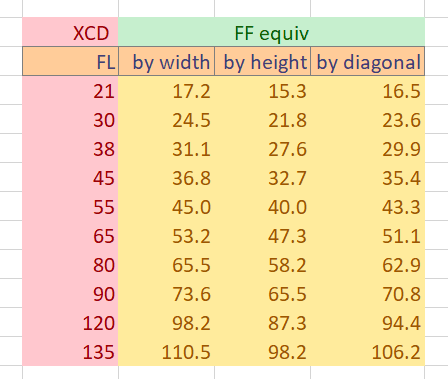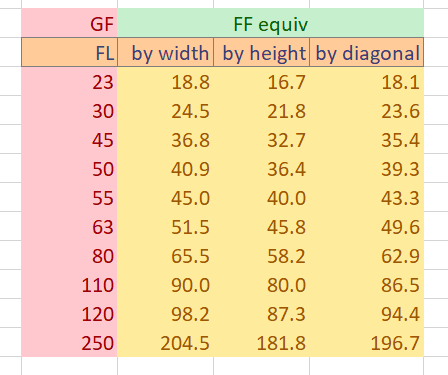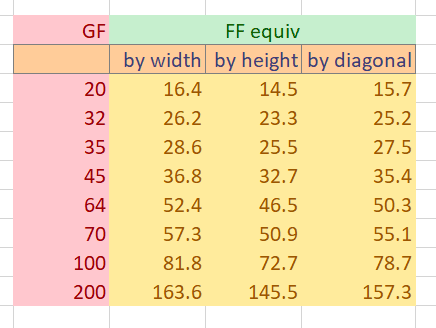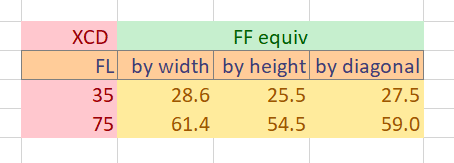The question of equivalent full frame focal lengths of the Fujifilm GF and Hasselblad XCD lenses comes up over and over. I thought I’d post that information here, and then I can link to it when the topic comes up again.
There are three common ways to calculate equivalent focal lengths: by sensor width, by sensor height, and by sensor diagonal. The equivalent FF focal length has the same angle of view as the MF sensor in that direction. It is conventional to assume the camera is held in landscape orientation for this calculation.
The primes:
The zooms, with both ends of the range calculated:




For Hasselblad lenses, you can refer to their datasheets for even more accurate FLs. I remember the actually FL for XCD21 is 21.8mm, so it is more like 17mm diagonally.
What makes you think their calculations are more accurate than mine?
Please link to their specifications of focal lengths that are different from those engraved on the lenses.
https://cdn.hasselblad.com/datasheets/xcd-lenses/XCD21-Datasheet-en.pdf
https://cdn.hasselblad.com/76a0253f-3df6-49d6-b37c-1934c22a4710_xcd21+datasheet+uk+180420.pdf
“Focal length 21,8 mm”
“Equivalent Focal length (24×36) 17 mm”
Hasselblad is actually wrong. They don’t take into account the aspect ratio 4:3 of their sensor 44×33.
21.8mm is equivalent in reality to 15.8mm when you take aspect ratio into account.
See my comment below about the maths.
I would like to share my maths if some people want to learn.
When comparing FF and 44×33, spect ratio should be taken into the account, since GFX is 4:3 and FF is 3:2. Shooting with 4:3 will not yield same focal lenght as shooting at 3:2.
Let me demonstrate the math:
First we have to convert full frame to 4:3 aspect ratio to match GFX 44×33 aspect ratio and thus compare apple to apples.
Cropped 4:3 full frame is 32×24 (previously 36×24) : 32^2 + 24^2 = 1600
Root of 1600 = 40
Full rame 3:2 will be 43.27 (calcuation :36^2+24^2=1872, root of 1872=43.27)
( Full frame 3:2) 43.27 / (cropped 4:3 FF) 40 = 1.08 (cropped ff 4:3 to true ff)
GFX 4:3:
44^2+33^2=3025
Root of 3025 = 55
Let’s compare gfx to cropped 4:3 ff:
40/55 = 0.727 (full number is 0.72727273 = ~0.73) crop factor of GFX to a cropped 4:3 full frame is 0.73
Here we go 0.727 is the crop factor of GFX to full frame, taking into account aspect ration, and representing a real crop factor.
It’s a lot simpler to say the crop factor is 24/33 = 0.7272727
Thank you !! I took the hardest route.
And big thanks for your work on that excel sheet with focal lenght. It’s so in depth!